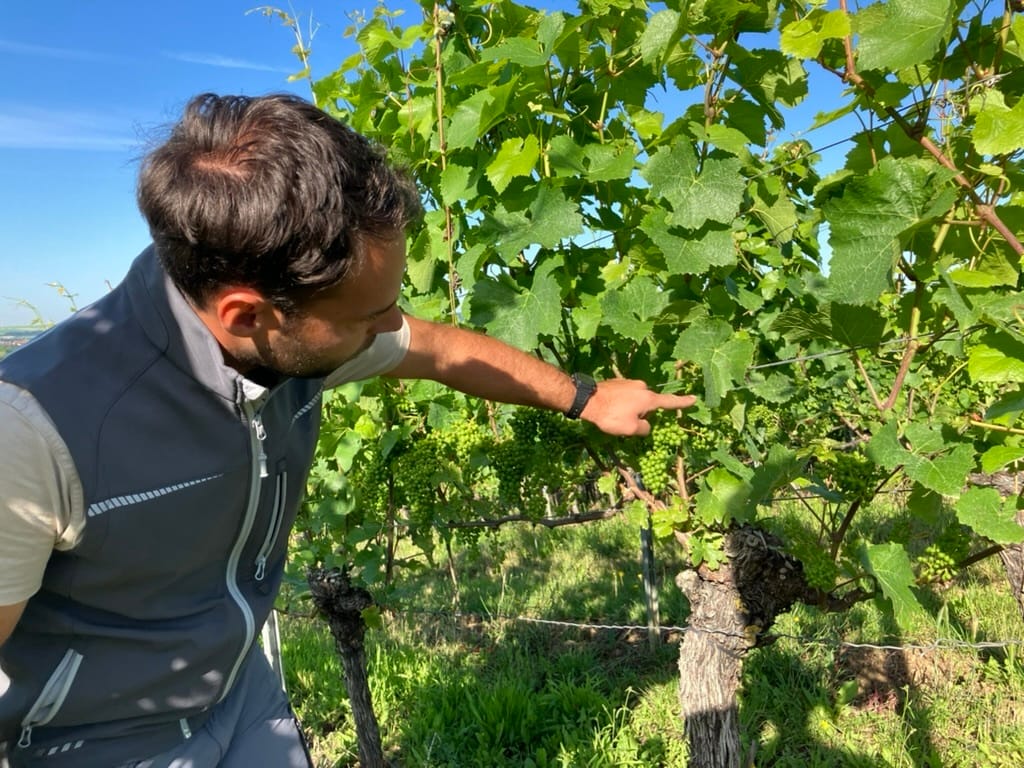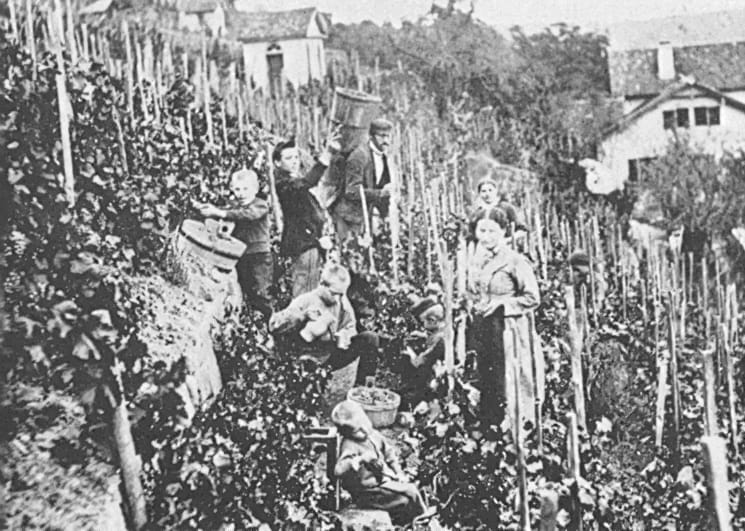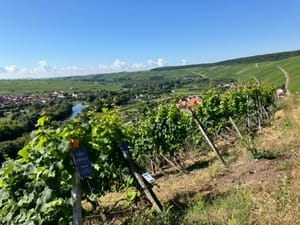This summer I stood with a young winzer named Peter Leipold on a hill in Obervolkach, a raft of houses upon an undulating sea of vineyards. Peter is the eighth generation of his family to make wine here. Most of these generations worked the land on the other side of the valley from where we were standing, but we had come to this side to visit thirteen rows of Silvaner vines in a plot called Schilfsandstein, from which he makes his top white wine. Like Peter, they’re the most recent addition to the family winery, purchased by his father in 2011. Peter was skeptical of the purchase at the time, but these vines quickly became his, the rows where he does almost all the work himself, by hand. Something about these few rows, he says, just stands out.
At seven hectares, the Leipolds’ is not a huge estate (a large winery will farm several hundred), but it’s large enough that they use machines for many vineyard tasks. While Peter’s clearly ambivalent about mechanization, he’s constrained by a combination of economics, labor availability, and a desire to make the best wine he can. Each vintage affords him an opportunity to make a new version of this tradeoff.
Take for instance the thinning of the foliage in late spring and summer, which winemakers call de-leafing. The goal is to clear leaves from around the immature grape bunches, aiding their ripening and reducing the chance of disease. Peter and his father used to do this by hand, but the two of them couldn’t keep up with the work – they couldn’t get to every parcel at the optimum time, and wouldn’t get to some vineyards at all.
So they bought a mechanized de-leafer, an attachment you can mount on a tractor. One such machine works much like a beard trimmer with a vacuum attached, and another uses pelletized air to blow leaves off the plant. If you watch these machines in action, it’s obvious why Peter keeps them out of Schilfsandstein. Mechanized de-leafing gives a sense of violence – leaves being shredded as though by machine gun fire.

But after driving the de-leafer through, Peter and his father walk every meter of the vineyard, plucking leaves from between the bunches as though they were flowers. A de-leafer can’t safely reach into the trellis that supports the vines, and the Leipolds realized that the foliage directly below the trellis, between the bunches, still shaded the grapes more than they wanted, so they began to do a pass by hand as well. They still de-leaf their best parcels, including Schilfsandstein, entirely by hand, to clear the foliage between the bunches right from the start.
De-leafing is a comparatively unromantic part of winemaking, like washing barrels or labeling bottles. Virtually no one who drinks wine even knows what the process is, let alone why it’s done; you don’t sell wine by saying the vines were de-leafed by hand. But every winery that harvests by hand trumpets that fact, and the harvest is one of the last activities a winery will mechanize. The Leipolds do theirs entirely manually, with a crew of local women in their 60s and 70s who’ve been working nearby harvests for decades.
This is in part because sentiment sells: Even today, most people have some notion of what a harvest festival is, and why we have them. Villages coming together, communal meals being eaten in the vineyard, the intense effort kindling friendship and romance… and even if you have no mental picture of what a harvest is actually like, saying that something comestible is made by hand is a blanket signal of virtue, the kind of thing you put on the package, like “all natural ingredients,” or “non-GMO”

But hand-harvesting is also a practical decision. The goal of a harvest is to bring ripe, clean, and intact grapes from the vineyard to the winery. This last requirement is key: Crushing a grape releases its sugary juices, which kickstarts fermentation, and winemakers want fermentation to start only under circumstances of their choosing. Deciding when to break a grape’s skin is a critical control point in winemaking, and harvesting by hand helps ensure that it occurs at the precise moment you want it to.
Here, again, machines are more violent. Most mechanized vineyard harvesters use pivotal strikers, a series of flexible rods that beat the vine to make it vibrate. This results in bringing a huge quantity of other material down from the vine, damaging the plants themselves — to say nothing of the grapes. Furthermore, mechanical harvesters feed the grape bunches into hoppers more than a meter deep, and from there into pallet bins for transport. Each of these processes tends to damage them.
So using a mechanical harvester requires a winemaker to accept imperfect control over the time and manner of the crush, which then demands other tradeoffs in the winemaking process. But a winemaker relying on inexperienced manual labor is also accepting something far from perfection – grapes that, while intact, may well be less than perfectly ripe, or diseased. Human harvesters have to know how to distinguish levels of ripeness, and to care enough to sort them, and neither of these is trivial when working at the necessary speed.
The Leipolds are lucky: Most European wineries have to rely on itinerant harvesters from Eastern Europe or North Africa, and the quality of harvest workers is a perennial concern. Peter himself wasn’t sure what he’d do once his local crew retired – their best harvester is seventy-five years old.
It’s unclear if mechanization is the solution or the problem. If Peter turns to machine harvesting after his team of omas retires, he’s reducing the range of employment available in Obervolkach even further, and probably accelerating the rural exodus. If he doesn’t, then he either has to make less wine, or rustle up a harvest team from somewhere else — and it won’t matter how much he’s willing to pay if he can’t find workers with the right skills.
Wine, perhaps alone of agricultural products today, can sometimes command a price high enough that everyone involved in the making could earn a living wage. The most expensive wines see extensive handwork, but their pricing tends to be justified less on the basis of the labor it took to make them than by the notion of terroir – the idea that agricultural products can “taste of a place.” In this sense wine is a technology itself: It allows us to “taste a place,” or at least believe we’re doing so.
But this train of thought runs straight to the belief that some places innately “taste better” than others, and are simply capable of producing “better” wines; no matter what we might think of the notion of terroir, it’s certainly the case that wines from certain regions command a higher price in the market. If we think of wine primarily in terms of terroir – a perspective that’s still a cornerstone of wine education – we position the land itself, rather than the people who make it, as the source of value. Care, in this view, is merely a handmaid to the greatness of the site.
Franconia isn’t exactly a world-famous wine region. Peter is searching, with some success, for an international market, but the Leipolds still sell most of their wine locally. Over a thousand households buy from them directly, and they “need their wine in liters.” A combination of momentum and devotion to the local community keeps them in this market, and as a consequence, a good proportion of their wine is drunk by people they actually know, people who sometimes had a hand in its making. This seems to me a wonderful thing. Wines as good as the Leipolds’ ought to be renowned in other countries, but they also ought to be drunk by the people who harvest the grapes.
SCOPE CREEP
Read the full story
The rest of this post is for paid members only. Sign up now to read the full post — and all of Scope of Work’s other paid posts.
Sign up now

